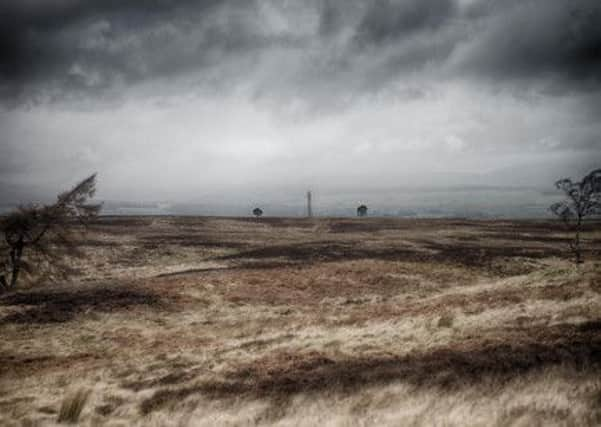100 Weeks of Scotland: Sheriffmuir


Week 76
I am standing on a massive reinforced concrete structure that stretches for almost a hundred metres across the boggy ground. I spotted it from the road, set off to the south from where the Ochil hills rise slowly before their dramatic drop towards Stirlingshire, Clackmannanshire and the Hillfoots. There seems utterly no logic to this structure, here in this landscape devoid even of colour. Yet, its solidity, its remoteness, its scale and most of all its absurdity can mean only one thing - the military.
Nazi mock-up
What I am standing on is, almost incredibly, a mock up of Rommel’s Atlantic Wall. The hundreds of miles of concrete, barbed wire and machine guns that stretched so miserably across Denmark, Holland, Belgium and France were, on a much smaller scale, recreated here in the early 1940s. Used as a training area for land and aerial attack this phony fragment of the Nazi defence of the continent was subjected to land and aerial attack as the allies sought to try and find some way of gaining a foothold on the murderous beaches of Fortress Europe.
Advertisement
Hide AdAdvertisement
Hide AdThis fragment of wall and the Tobruk-style stone bunkers that lie to either side of it are fearsome enough, on this silent an grey spring day. What they would have been like for real, spitting fire and death, is almost impossible to imagine.
Jacobites
Sheriffmuir has seen conflict before though, and previously it was not a training exercise. A mile or two from where I stand is another construction of stone and concrete, this time in commemoration of an earlier war – the Jacobite uprising of 1715. The battle of Sheriffmuir took place in November 1715 between the Jacobite forces of the Earl of Mar and the Government army led by the Duke of Argyll. A draw was the official result although it was seen as a tactical victory for the Government. To the 15 or 16 hundred killed on both sides though, it must have felt like nothing more than a bloody and painful defeat.
I am here in mid Spring and it is bitingly cold. That these two armies chose to meet here, in the depths of a Scottish winter, instead of the far more accessible land in the valley below seems like madness to me. But then is it any more insane than the whole concept of pitched battles where reluctant peasant and farmhands were spurred on to fight to preserve the lands and riches of a few ruling families? Flodden in 1513, Bannockburn in 1314 and Sheriffmuir in 1715 seem to emphasise that Scotland in the second decade of a new century is a momentous place to be.
Bleak but beautiful
To reach Sheriffmuir from Stirling the road winds past the lovely campus of Stirling University, initially up tree-lined roads so green and verdant that they are breathtaking in their unexpectedness. Before long the moor is reached and ahead, stretching far to the north lies a bleak country so completely out of keeping with the greenery of the landscape so recently left behind.
It is beautiful though. It is wild, barely travelled, scoured by freezing winds and lashed by needle rains. It is slap bang in the middle of central Scotland and yet will never be visited by the vast majority of the population.
It is within an hours drive of 90 per cent of the inhabitants of Scotland but I would be amazed if even 1 per cent had ever been this way. It is, like so many rarely visited places, hidden in plain view. The height and elevation that make it visible for miles around, also keep it secluded and off the beaten track.
‘Like the far side of the moon’
I love areas like this. So close and yet they seem like the far side of the moon. On top of my little piece of the Atlantic Wall I can see for miles – and I swear I can feel for centuries. People and time have moved slowly through this small bit of Scotland – the tides and the storms of history may buffet the lowlands below, yet up here amidst quiet; amidst the moor and the rocks and the hills, none of it seems to make the slightest difference.
• Alan McCredie began the ‘100 weeks of Scotland’ website in October last year, and it will conclude in Autumn 2014. McCredie’s goal is to chronicle two years of Scottish life in the run-up to the independence referendum.
Advertisement
Hide AdAdvertisement
Hide AdAlan says ‘one hundred weeks...’ is intended to show all sides of the country over the next two years. On the site, he says: “Whatever the result of the vote Scotland will be a different country afterward. These images will show a snapshot of the country in the run up to the referendum.
“The photos will be of all aspects of Scottish culture - politics, art, social issues, sport and anything else that catches the eye.”
Follow the project at www.100weeksofscotland.com. You can also follow Alan on Twitter @alanmccredie.